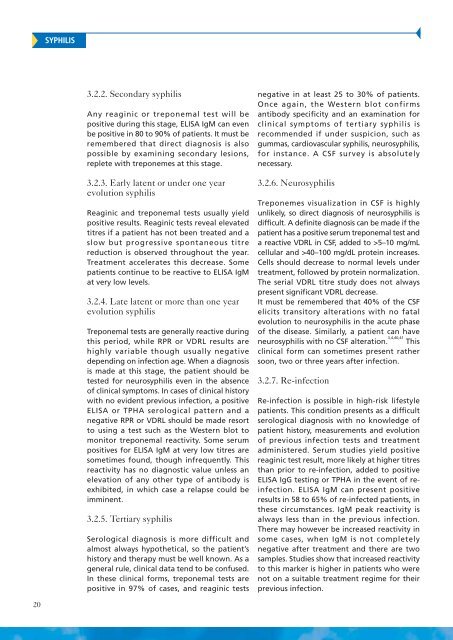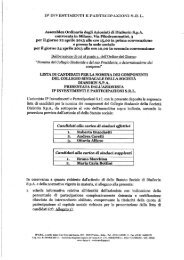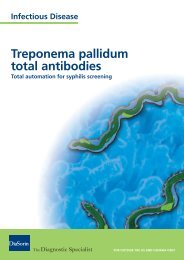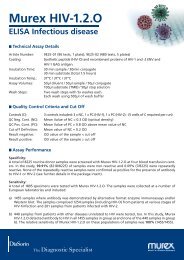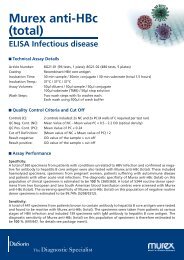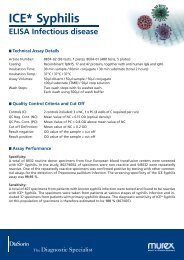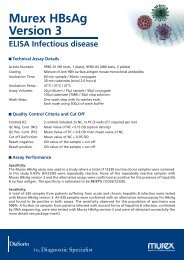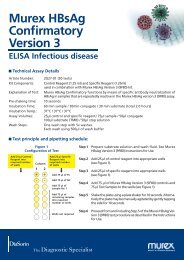Syphilis Booklet - DiaSorin
Syphilis Booklet - DiaSorin
Syphilis Booklet - DiaSorin
You also want an ePaper? Increase the reach of your titles
YUMPU automatically turns print PDFs into web optimized ePapers that Google loves.
SYPHILIS<br />
3.2.2. Secondary syphilis<br />
Any reaginic or treponemal test will be<br />
positive during this stage, ELISA IgM can even<br />
be positive in 80 to 90% of patients. It must be<br />
remembered that direct diagnosis is also<br />
possible by examining secondary lesions,<br />
replete with treponemes at this stage.<br />
3.2.3. Early latent or under one year<br />
evolution syphilis<br />
Reaginic and treponemal tests usually yield<br />
positive results. Reaginic tests reveal elevated<br />
titres if a patient has not been treated and a<br />
slow but progressive spontaneous titre<br />
reduction is observed throughout the year.<br />
Treatment accelerates this decrease. Some<br />
patients continue to be reactive to ELISA IgM<br />
at very low levels.<br />
3.2.4. Late latent or more than one year<br />
evolution syphilis<br />
Treponemal tests are generally reactive during<br />
this period, while RPR or VDRL results are<br />
highly variable though usually negative<br />
depending on infection age. When a diagnosis<br />
is made at this stage, the patient should be<br />
tested for neurosyphilis even in the absence<br />
of clinical symptoms. In cases of clinical history<br />
with no evident previous infection, a positive<br />
ELISA or TPHA serological pattern and a<br />
negative RPR or VDRL should be made resort<br />
to using a test such as the Western blot to<br />
monitor treponemal reactivity. Some serum<br />
positives for ELISA IgM at very low titres are<br />
sometimes found, though infrequently. This<br />
reactivity has no diagnostic value unless an<br />
elevation of any other type of antibody is<br />
exhibited, in which case a relapse could be<br />
imminent.<br />
3.2.5. Tertiary syphilis<br />
Serological diagnosis is more difficult and<br />
almost always hypothetical, so the patient’s<br />
history and therapy must be well known. As a<br />
general rule, clinical data tend to be confused.<br />
In these clinical forms, treponemal tests are<br />
positive in 97% of cases, and reaginic tests<br />
negative in at least 25 to 30% of patients.<br />
Once again, the Western blot confirms<br />
antibody specificity and an examination for<br />
clinical symptoms of tertiary syphilis is<br />
recommended if under suspicion, such as<br />
gummas, cardiovascular syphilis, neurosyphilis,<br />
for instance. A CSF survey is absolutely<br />
necessary.<br />
3.2.6. Neurosyphilis<br />
Treponemes visualization in CSF is highly<br />
unlikely, so direct diagnosis of neurosyphilis is<br />
difficult. A definite diagnosis can be made if the<br />
patient has a positive serum treponemal test and<br />
a reactive VDRL in CSF, added to >5–10 mg/mL<br />
cellular and >40–100 mg/dL protein increases.<br />
Cells should decrease to normal levels under<br />
treatment, followed by protein normalization.<br />
The serial VDRL titre study does not always<br />
present significant VDRL decrease.<br />
It must be remembered that 40% of the CSF<br />
elicits transitory alterations with no fatal<br />
evolution to neurosyphilis in the acute phase<br />
of the disease. Similarly, a patient can have<br />
neurosyphilis with no CSF alteration. 3,4,40,41 This<br />
clinical form can sometimes present rather<br />
soon, two or three years after infection.<br />
3.2.7. Re-infection<br />
Re-infection is possible in high-risk lifestyle<br />
patients. This condition presents as a difficult<br />
serological diagnosis with no knowledge of<br />
patient history, measurements and evolution<br />
of previous infection tests and treatment<br />
administered. Serum studies yield positive<br />
reaginic test result, more likely at higher titres<br />
than prior to re-infection, added to positive<br />
ELISA IgG testing or TPHA in the event of reinfection.<br />
ELISA IgM can present positive<br />
results in 58 to 65% of re-infected patients, in<br />
these circumstances. IgM peak reactivity is<br />
always less than in the previous infection.<br />
There may however be increased reactivity in<br />
some cases, when IgM is not completely<br />
negative after treatment and there are two<br />
samples. Studies show that increased reactivity<br />
to this marker is higher in patients who were<br />
not on a suitable treatment regime for their<br />
previous infection.<br />
20


